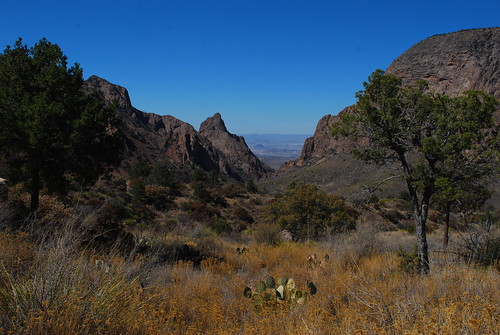
We had only two days of hiking in the desert — it was just a weekend trip, but we managed to see the best parts of the national park. I was surprised, actually, at the utter lack of tourists in what was a spectacular landscape. At several trailheads, our rental car was the only vehicle. The young woman at the visitor center told us that things get busy in March, when college students are on spring break.
Along the shallow river, men sometimes came riding across on horses, usually carrying handmade trinkets — including scorpions made of wire — that they’d spread out on a flat rock. They were always careful to give prices in terms of “suggested donations” since selling things across the border is illegal. One man told us that both countries used to be very casual about the border crossings, and that boat trips often meandered back and forth, with Americans going into the little Mexico towns for drinks and food, but that the Americans had gotten stricter in 2002.
We did see some wildlife, including roadrunners who looked very much like the cartoon version I’d grown up with, minus the sound effects. I liked that we were hiking in the presence of mountain lions, but we never actually saw one: no doubt they’d found a place to sleep in the shade. We came across a pack of javelinas, who looked tough and prickly, as you might expect in that climate, jack rabbits who darted in front of the car, and a coyote trotting along at dusk.
Late one afternoon, we found out where the handful of Americans in the park were hanging out: a natural hot spring on the edge of the river. Years ago, the place had been a working spa, and the old walls of the bath area were still in tact. After several hours of hiking, it felt great to relax in the warm water. The afternoon sun glinted off the river that swirled past, and golden grasses swaying in the breeze all around us. No one talked much: we sat lazily, while on the other side of the river, a couple of men napped in the shade of an old tree and a burro chewed on dry grass.
In our search for supplies one morning, we drove through a ghost town. The town had been built over a hundred years ago when mercury mining in the area was profitable. The thing that struck me most about the abandoned houses is that there were no trees or plants to cover them up: the desert landscape is stark. We walked around the little cemetery, where rocks and crosses marked the graves of those who had lived and worked here long ago.
On our last morning, we drove along a windy road into the mountains. Hidden in a valley, with peaks on every side, was an oasis with more vegetation that we'd seen the whole trip. We found a spot where we could sit in the shade and enjoy the breeze. I could see why early humans would have made this their home: having mountains on all sides made me feel protected.


6 comments:
That park is packed in the summer, and can you imagine hiking in heat over a hundred degrees? You really went at the best time.
roadrunners who looked very much like the cartoon version I’d grown up with, minus the sound effects.
Nobody shouted out, "Meep, meep!" ???
I remember the first time I saw roadrunners, I was surprised how small they were. I guess I was thinking they'd be closer to Wile E. Coyote in size. :-)
Tie-Dye Brother-in-law: Actually, my husband yelled "Meep, meep!" every time he saw one. He couldn't resist.
I grew up with a pretty small television set, so the roadrunners looked just about right in size.
Nels: Yeah, the temperatures were just about perfect, and the weather was such a great contrast to the cold here in Snowstorm Region. I was surprised not to find more people there. I know lots of people who go to Disney in February -- I'd choose Big Bend every time.
It looks beautiful -- As for those mountain lions, I love that they're around, too all the while wondering if they're going to eat me. I just read this morning that the Eastern version has been declared extinct -- last one seen 70 years ago in Maine. Sad.
Yes, that story is here. The Eastern cougar is extinct.
Another loss.
Post a Comment